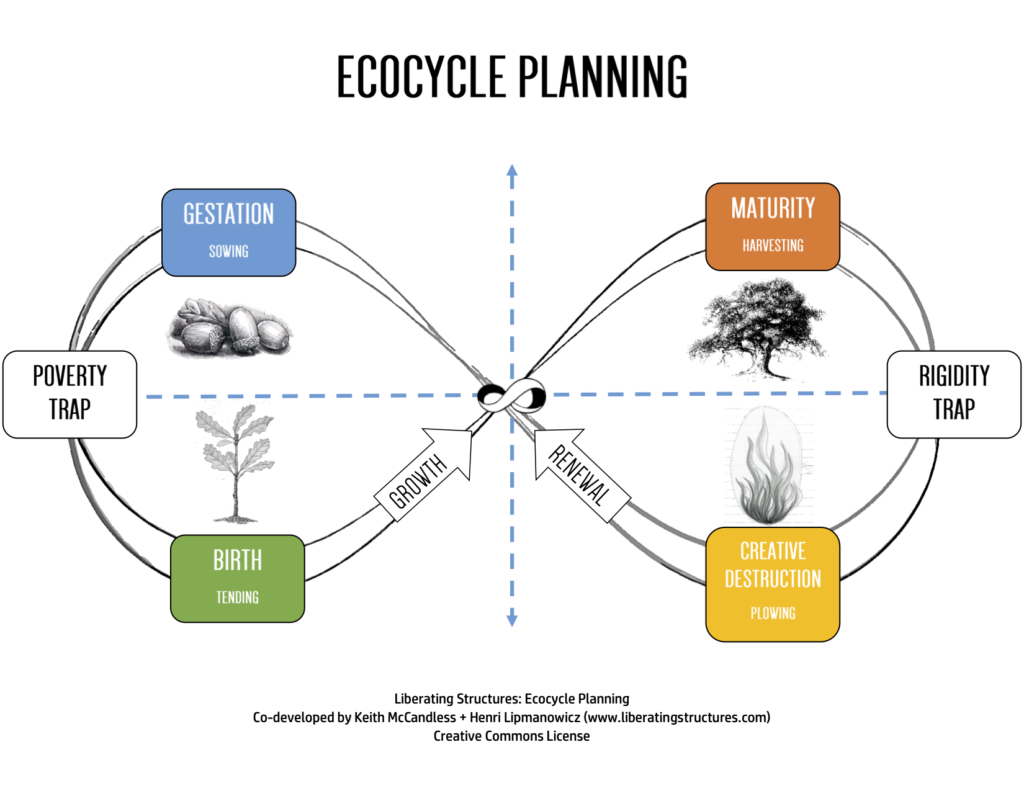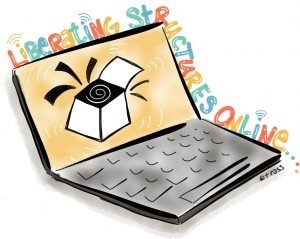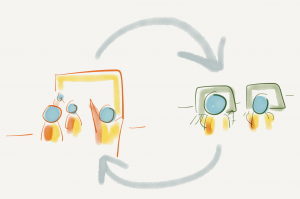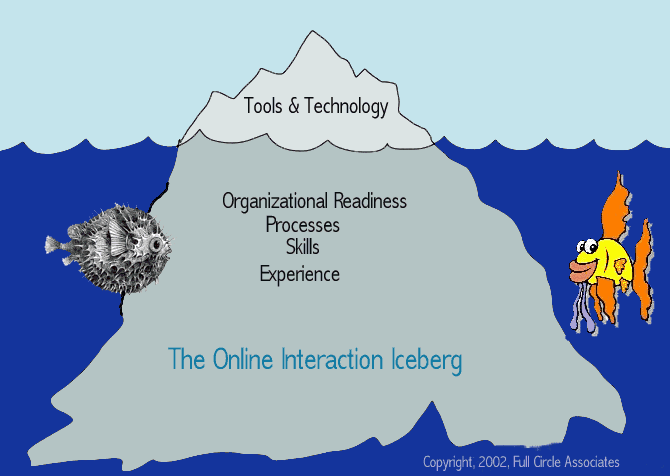This is the second of a series of posts to support anyone working to move their offline/face to face group interactions online. The preamble is here. If you are an online facilitator or finding yourself in that role, join our group g here. If you are looking for resources, check here.

In the preamble, I shared my thinking that we need to avoid starting with technology, or even the redesigned agenda as we move online. To make progress, we need to pause and pay attention to what is shifting in the systems around us. Use something like the Ecocycle to get a sense of what is happening at a systems level.
Here is a description of Ecocyle Planning from the Liberating Structures website:
Ecocycle Planning – Analyze the Full Portfolio of Activities and Relationships to Identify Obstacles and Opportunities for Progress What is made possible?
http://www.liberatingstructures.com/31-ecocycle-planning/
You can eliminate or mitigate common bottlenecks that stifle performance by sifting your group’s portfolio of activities, identifying which elements are starving for resources and which ones are rigid and hampering progress. The Ecocycle makes it possible to sift, prioritize, and plan actions with everyone involved in the activities at the same time, as opposed to the conventional way of doing it behind closed doors with a small group of people. Additionally, the Ecocycle helps everyone see the forest AND the trees—they see where their activities fit in the larger context with others. Ecocycle Planning invites leaders to focus also on creative destruction and renewal in addition to typical themes regarding growth or efficiency. The Ecocycle makes it possible to spur agility, resilience, and sustained performance by including all four phases of development in the planning process.
By seeing the whole, diving into the details, and then zooming back to the whole helps us discern a direction forward and useful first steps for moving your meetings online and especially when we are in complex contexts.
I find Ecocyle helps me focus and prioritize rather than get stuck in all the possibilities and challenges. Because it is built upon a flow, we can observe what is moving forward, what is stuck and where we may be over or under-investing our time and resources. If we spend all our time perpetuating our ok-but-not-wonderful F2F meetings with an unthinking transition to online, we may be making a total mess of things. If we pick just ONE way of going forward, we may lose sight of new, emerging possibilities. If we rush to a single solution, we may miss the possibilities of those who think differently, the positive deviants and ideas that need space to emerge. Ecocycle situates our work in flow and flux, rather than a linear to do list or rigid plan.
Just one more note before we dig in to how to do this. Sometimes we need to clear the field a bit. In this case, fear can cripple. Liberating Structures co-founder Keith McCandless’s work on LS started with superbug infection reduction in hospitals. Keith has been reflecting these past few days about the importance of getting past fear. He has created a playful process you might want to consider, a Pandemic Mad Tea. It can be a well spent 10-15 minutes and really get folks deep into their work, right from the start. (If you want to gain more insights from Keith and his infection reduction work applied to the emerging shut down of the SXSW in Austin this month. Check out this sketch. It was designed for a F2F conversation, but it gives some very specific Covid-19 context.)
How to Ecocycle Your Move to Online Meetings
- Don’t work alone. Engage your colleagues.
- Turn on the camera. Presumably you can’t meet face to face (F2F) with your team, so fire up your video conference software and turn on the cameras. YES REALLY, TURN ON THE CAMERAS!
- Read about the basics of Ecocycle on the Liberating Structures website. Then briefly discuss your understanding with each other. Don’t worry if it feels confusing, and don’t spend too much time on this step. We are going to DO it together and then things will clarify!
- Get a piece of paper, pens, post its. Draw the basic Ecocycle structures on the paper and get ready to start writing on it, putting post it notes – whatever. This is for your own personal doodling/note taking. Next you can do it digitally together.
- Make a copy of this Ecocycle Online template and share with your team.
- Follow the steps of doing Ecocycle Planning in the template. I’m including the steps here below in case you want to print them out as well.
- First alone, make a list of all the things swirling in your mind about moving your meetings online. What are your activities? What are your most important stakeholder and collaborator relationships?
- Place each activity and/or relationships on your list on your paper Ecocycle in one four developmental phases: birth, maturity, creative destruction, and renewal.What are you doing but you feel it really isn’t working. Position those around the “rigidity trap.” If you have already resolved to stop doing those things, put them in “creative destruction.” Things that have been suggested to you or which you are thinking about, but haven’t yet taken any action on, put in the “gestation area.” Note any really terrific ideas that you really think should move forward, but which are stuck (for whatever reasons) and put them near the “poverty trap” box. Finally, locate all the experiments or pilots in process (both before and in response to the pandemic) in the “birth” area.
- Build your collective Ecocycle. In your web meeting room, share your items with each other. Discuss the placement of each of your items. You can use a shared whiteboard, Google slides (the template) using self made “post its” with the drawing tool, or share your paper artifacts on camera. Notice what you share that is similar and what is different (there is always useful information in noting both!) NOTE: If your team is more than 4 people, you may want to use your online breakout room and start in pairs, then build up to the whole. Yes, it is worth the time. In pairs you can hear and be heard and discern details that might start to get lost as you think together in a larger group. 1-2-4-All can help you tap your collective intelligence faster than a whole group conversation, even as it feels like it slows things down. Don’t worry!
- Look at the details. Spend time discussing items that you feel belong in different areas. Tip: if something feels like it fits into multiple areas, break it down into its component elements. Things can get clearer.
- Look at the big picture. Together discuss what you see. What patterns do you see? Where are there many elements? Few? Look on the middle right, in the “rigidity trap.” Your most liberating first step may be to decide what to STOP doing in order to make space for new and more useful meeting practices (online or off!) Too many things in gestation? Start with the great ideas that are getting stuck in the poverty trap. See promising initiatives in birth? What one step could you take to support and amplify those efforts. See MANY things in gestation? Consider gathering those folks and learn how and why they are succeeding taking their meetings online and build on current energy and success. (Consider “Discovery and Action Dialog” as a process.)
- Decide what the next step will be moving your meetings online. You might want to consider Purpose to Practice which starts with getting clear on the PURPOSE of going online. Dig deep until you hit the hard-rock purpose!
In the longer term Ecocycle offers us approaches and mechanisms to adapt as conditions continue to change. In other words, there is no magic technology, group process approach or perfect online meeting template, so give that up. Right now is time for evolving!
P.S. Really pay attention to Creative Destruction. Don’t take poor meeting practices from offline into the online space. They only deteriorate! In a future post in this series I’ll share some fabulous alternatives!
P.S.S. The use of Ecocycle can help make sense at many levels. This article explores Covid-19 at the global level. https://medium.com/insurge-intelligence/coronavirus-synchronous-failure-and-the-global-phase-shift-3f00d4552940







